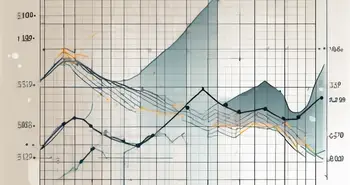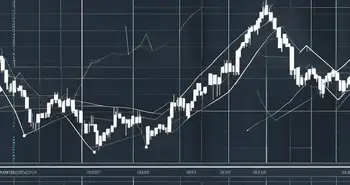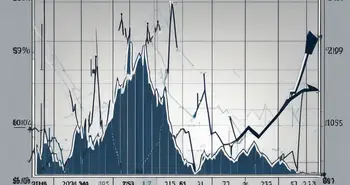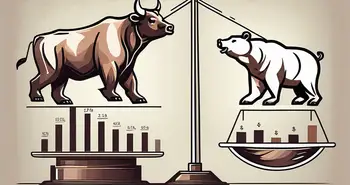Gamma Trading: Strategies for Success in Options Markets

Welcome to the ultimate guide to gamma trading! In this comprehensive article, we will explore everything you need to know about gamma trading, from the basics to advanced strategies and risk management techniques. So, whether you're a seasoned trader looking to enhance your portfolio or a beginner curious about exploring new trading strategies, this guide has got you covered!
Understanding the Basics of Gamma Trading
Gamma trading is a popular strategy in the world of options trading. But what exactly is gamma trading? In simple terms, gamma refers to the rate at which an option's delta changes in relation to a change in the underlying asset's price. Gamma trading seeks to take advantage of this relationship by profiting from changes in volatility and market movements.
When it comes to options trading, gamma plays a crucial role in determining the potential profit or loss of a position. Understanding this relationship is vital for successful gamma trading.
What is Gamma Trading?
Gamma trading involves actively managing and adjusting options positions based on changes in the underlying asset's price and volatility. By taking positions with positive gamma, traders can profit from large movements in the underlying asset, while positions with negative gamma can provide stability in times of low volatility.
The Importance of Gamma in Options Trading
Gamma is essential because it determines how an option's value will change as the underlying asset's price fluctuates. By monitoring and managing gamma, traders can effectively navigate changing market conditions and potentially increase their returns.
For example, when an option has a high gamma value, it means that its delta will change significantly for every unit change in the underlying asset's price. This can be advantageous when anticipating large price movements.
Key Terms in Gamma Trading
Before diving deeper into gamma trading strategies, it's crucial to be familiar with key terms used in this field. Here are a few important terms to know:
- Delta: The rate of change in an option's price in relation to changes in the underlying asset's price.
- Gamma: The rate of change in an option's delta in response to changes in the underlying asset's price.
- Vega: Measures the sensitivity of an option's price to changes in implied volatility.
- Theta: Calculates the rate at which an option's value will decrease over time due to the passage of time or time decay.
The Mechanics of Gamma Trading
Now that we have a solid foundation of gamma trading, let's take a closer look at how it works and the factors to consider when implementing a gamma trading strategy.
How Gamma Trading Works
Gamma trading involves trading options with different strikes to take advantage of changing price movements. Traders typically adjust their positions as the underlying asset's price moves, effectively managing their exposure to gamma risk.
For instance, when the underlying asset's price increases, options with strike prices closer to the current price tend to have higher gamma values. Traders capitalize on these high gamma positions to profit from the price movement.
Conversely, when the underlying asset's price decreases, options with strike prices further away from the current price can provide higher gamma values. In these scenarios, traders can benefit from the stability offered by these positive gamma positions.
The Role of Delta in Gamma Trading
Delta is a crucial element in gamma trading. It represents the degree to which an option's price will change in response to a change in the underlying asset's price. By understanding the relationship between delta and gamma, traders can effectively manage their positions and maximize profits.
When an option has a high gamma value, it means its delta can change rapidly. Traders can adjust their positions accordingly to capture potential gains during significant price movements.
Understanding Gamma Risk
While gamma trading offers significant profit potential, it is important to understand and actively manage the associated risks. One primary risk in gamma trading is the possibility of losses when the underlying asset's price remains stagnant or exhibits minimal movements.
To mitigate this risk, it's crucial to carefully monitor positions, adjust them as needed, and maintain a diversified portfolio. Avoiding excessive concentration in a single asset or sector can help reduce the impact of stagnant prices on gamma trading profitability.
Strategies for Successful Gamma Trading
Now that we have a solid understanding of gamma trading mechanics and risks, let's explore some popular strategies that can help enhance your results.
Long Gamma Trading Strategy
The long gamma trading strategy involves establishing positions with positive gamma to profit from significant price movements in the underlying asset. This strategy can be particularly useful when anticipating increased market volatility or significant news events that may impact the asset's price.
For example, suppose you anticipate an earnings announcement that could potentially cause a significant price movement in a specific stock. By establishing long gamma positions through options, you can benefit from the price movement while limiting potential losses.
It's important to note that with long gamma positions, time decay can impact their profitability. Thus, it is crucial to actively manage and adjust positions as needed to optimize returns.
Short Gamma Trading Strategy
The short gamma trading strategy, also known as selling or writing options, involves taking positions with negative gamma. Traders employing this strategy benefit from stable market conditions with minimal price fluctuations.
By selling options and collecting premiums, short gamma traders seek to profit from the passage of time and the decay of extrinsic value in options contracts. This strategy can be effective in markets with low volatility or when premium levels are perceived as elevated.
However, it is important to manage risk effectively when employing the short gamma strategy. Market movements against short gamma positions can result in significant losses.
Neutral Gamma Trading Strategy
The neutral gamma trading strategy aims to maintain a balanced portfolio with a near-zero gamma exposure. Traders using this approach typically construct positions that offset the positive and negative gamma values, reducing overall portfolio volatility.
Neutral gamma trading can be advantageous when expecting stable market conditions or when pursuing a risk-averse approach. By minimizing gamma exposure, traders can limit the potential impact of market movements on their positions, aiming for consistent and steady returns.
Managing Risks in Gamma Trading
Successful gamma trading involves not only understanding the strategies but also effectively managing the associated risks. Let's explore some key considerations for risk management in gamma trading.
Identifying Potential Risks
Identifying and understanding potential risks is crucial in any trading strategy, including gamma trading. Some common risks associated with gamma trading include:
- Gamma risk: The potential for losses due to adverse price movements or stagnant market conditions
- Liquidity risk: Difficulty entering or exiting positions due to low trading volumes
- Execution risk: Errors or delays in trade execution, which can impact profitability
By thoroughly assessing and regularly monitoring these risks, traders can make informed decisions and manage potential losses effectively.
Tools for Risk Management in Gamma Trading
Fortunately, there are various tools and techniques available to help mitigate risks in gamma trading:
- Stop-loss orders: Placing stop-loss orders can automatically close positions at specified price levels, helping limit potential losses.
- Position sizing: Carefully determining the appropriate size of each position in relation to the overall portfolio can help manage risk.
- Portfolio diversification: Spreading investments across different assets, sectors, and strategies can help reduce exposure to specific risk factors.
By utilizing these risk management tools, traders can enhance their overall gamma trading strategy and protect themselves from unexpected market movements.
Mitigating Losses in Gamma Trading
Losses are an inevitable part of trading, and gamma trading is no exception. However, by employing prudent risk management techniques and maintaining a disciplined approach, traders can mitigate potential losses and safeguard their capital.
One effective approach is to set realistic profit targets and adhere to a robust exit strategy. Avoiding the temptation to chase excessive returns and carefully assessing each trade can help minimize losses and preserve capital for future opportunities.
FAQ – Frequently Asked Questions
What is gamma trading?
Gamma trading involves actively managing and adjusting options positions based on changes in the underlying asset's price and volatility. Traders aim to profit from the relationship between gamma and the underlying asset's movement.
What are the key terms in gamma trading?
- Delta: The rate of change in an option's price relative to changes in the underlying asset's price.
- Gamma: The rate of change in an option's delta in response to changes in the underlying asset's price.
- Vega: Measures the sensitivity of an option's price to changes in implied volatility.
- Theta: Calculates the rate at which an option's value will decrease over time due to the passage of time or time decay.
What are the strategies for successful gamma trading?
There are several strategies for successful gamma trading, including the long gamma strategy, short gamma strategy, and neutral gamma strategy. Each strategy involves different approaches to capitalize on market movements and volatility conditions.
How can I manage risks in gamma trading?
Risk management is crucial in gamma trading. Some key considerations include identifying potential risks, utilizing risk management tools, such as stop-loss orders and proper position sizing, and diversifying your portfolio. By effectively managing risks, traders can safeguard their capital and enhance overall trading performance.
How can I mitigate losses in gamma trading?
To mitigate losses in gamma trading, it is important to set realistic profit targets, adhere to a disciplined exit strategy, and avoid chasing excessive returns. Additionally, implementing prudent risk management techniques, such as portfolio diversification and effective stop-loss orders, can help minimize losses and protect capital.
With this comprehensive guide, you now have a solid understanding of gamma trading, from the basics to advanced strategies and risk management techniques. However, always remember that successful trading requires continuous learning, adaptability, and a disciplined approach. So, stay curious, stay informed, and keep refining your skills to navigate the dynamic world of gamma trading confidently.
Ready to elevate your gamma trading strategy with a platform that's as innovative as your approach? Discover Morpher.com, where the fusion of blockchain technology and trading meets. With zero fees, infinite liquidity, and the ability to engage in fractional investing and short selling, Morpher is designed to revolutionize your trading experience. Take control of your investments with the Morpher Wallet, leverage your trades up to 10x, and explore unique markets like never before. Sign Up and Get Your Free Sign Up Bonus today to join a community of traders who are shaping the future of investing.

Disclaimer: All investments involve risk, and the past performance of a security, industry, sector, market, financial product, trading strategy, or individual’s trading does not guarantee future results or returns. Investors are fully responsible for any investment decisions they make. Such decisions should be based solely on an evaluation of their financial circumstances, investment objectives, risk tolerance, and liquidity needs. This post does not constitute investment advice.

Painless trading for everyone
Hundreds of markets all in one place - Apple, Bitcoin, Gold, Watches, NFTs, Sneakers and so much more.

Painless trading for everyone
Hundreds of markets all in one place - Apple, Bitcoin, Gold, Watches, NFTs, Sneakers and so much more.








